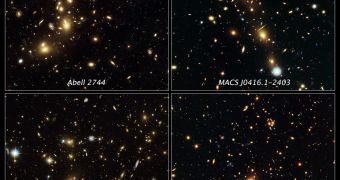NASA is putting all of its space telescopes to good use in the pursuit of going farther back in time than we've ever been. Hubble, Spitzer and Chandra will be pooling resources and scouring the skies for very faint and distant galaxies.
"In an ambitious collaborative program called The Frontier Fields, astronomers will make observations during the next three years peering at six massive clusters of galaxies, exploiting a natural phenomenon known as gravitational lensing, to learn not only what is inside the clusters but also what is beyond them," NASA explained.
Alone, none of the telescopes would be able to see this far out. Even all of them used together couldn't do much better. This is why astronomers are using a natural phenomenon, the bending of light by gravity, to see farther out than they normally could.
"The clusters are among the most massive assemblages of matter known, and their gravitational fields can be used to brighten and magnify more distant galaxies so they can be observed," NASA added.
The study will focus first on Abell 2744, or Pandora's Cluster, a very large group of galaxies that was probably formed from the collision of four different clusters.
Hubble and Spitzer data will be used together to assert how far away and how big the galaxies are. Hubble operates in the visible light spectrum, but is also capable of seeing light in the near ultraviolet and near infrared. Spitzer is a pure infrared space telescope.
With the gravitational lensing effect, they should be able to see galaxies that date from when the universe was only a few hundreds of millions of years old.
Meanwhile, the Chandra space telescopes, which operates in the X-ray spectrum, will try to determine the distribution of dark matter inside the massive cluster, by looking at how the galaxies are affected by gravity.

 14 DAY TRIAL //
14 DAY TRIAL //